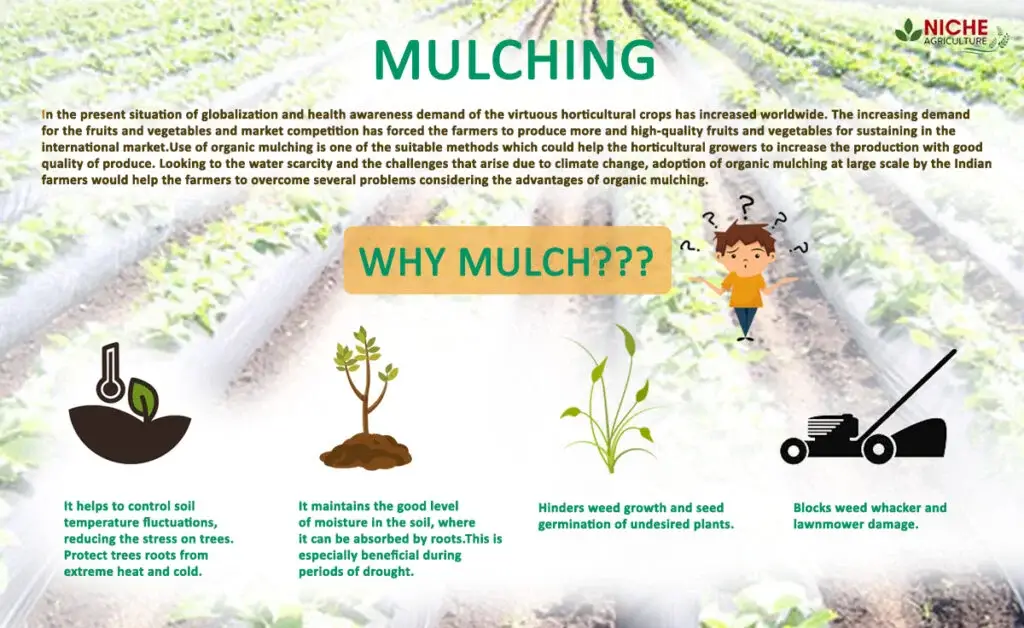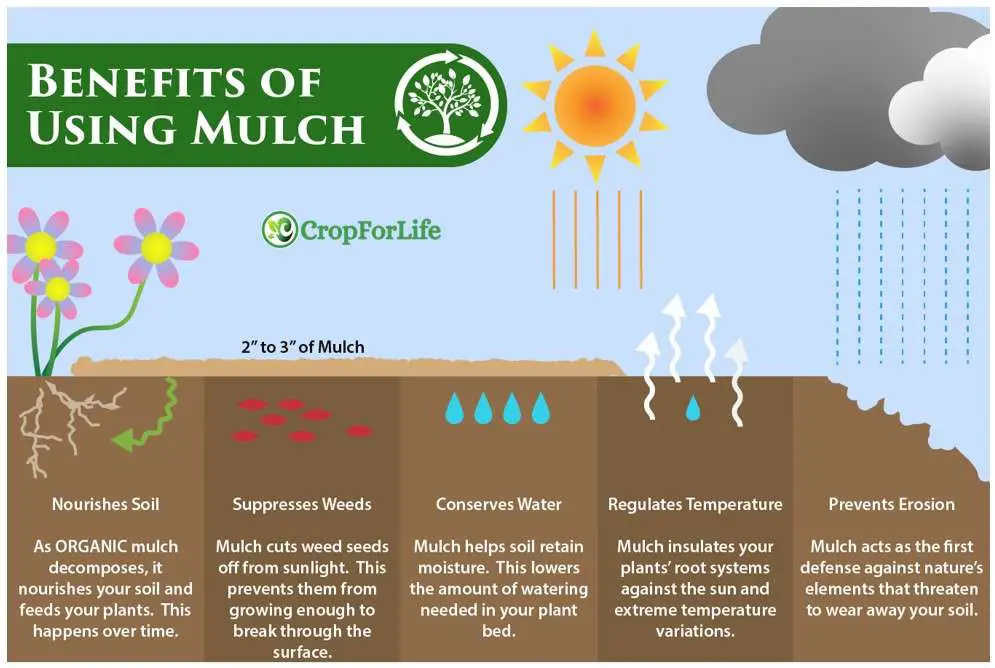Mulching has its pros and cons that need to be considered before incorporating it into your gardening routine. Organic mulches, while effective in retaining moisture and suppressing weeds, can attract pests and potentially lead to root rot if used excessively. On the other hand, inorganic mulches have the potential to dry out the soil and harm plants if not used carefully. Additionally, factors like location and climate can influence the effectiveness of mulching. It’s important to monitor and adjust the mulch as needed, as it may require extra effort and cost. Despite these drawbacks, proper mulching practices can help mitigate the disadvantages and offer benefits such as temperature regulation, soil improvement, and moisture retention. Remember, for optimal results, mulching should be combined with other gardening techniques.
Advantages of Mulching
Moisture Retention
Mulching helps retain moisture in the soil by acting as a protective barrier between the soil and the elements. It reduces evaporation by shading the soil surface, preventing water from escaping into the atmosphere. This is particularly beneficial in dry or arid climates where water conservation is crucial.
Weed Suppression
One of the major advantages of mulching is its ability to suppress weed growth. By blocking sunlight from reaching the soil surface, mulch prevents weed seeds from germinating and reduces the need for manual weeding. This not only saves time and effort but also contributes to a healthier garden ecosystem by minimizing competition for nutrients and water.
Temperature Regulation
Mulching acts as a natural insulator, regulating soil temperature and protecting plant roots from extreme fluctuations. In hot climates, mulch helps keep the soil cooler by shading it from the sun’s direct rays. Similarly, in colder regions, mulch provides a protective layer that helps retain soil warmth and prevents frost damage.
Soil Improvement
Mulching promotes soil health and fertility by improving its structure and moisture-holding capacity. Organic mulches, such as compost or wood chips, break down over time, enriching the soil with organic matter and essential nutrients. As the mulch decomposes, it also enhances soil aeration and drainage, creating a more hospitable environment for beneficial soil organisms.
Enhanced Plant Growth
Mulching creates favorable conditions for plant growth by providing a stable environment with consistent moisture levels and temperature. This enables plants to establish their root systems more easily and absorb nutrients efficiently, leading to healthier growth and increased productivity.
Protection from Extreme Weather Conditions
Mulch acts as a protective shield, safeguarding plants from extreme weather conditions such as heavy rain or strong winds. It prevents soil erosion by reducing the impact of raindrops and helps preserve the integrity of plant roots. Additionally, mulch can insulate plants from frost or freeze damage during cold spells.
Reduced Soil Erosion
By covering the soil surface, mulch helps prevent erosion caused by the impact of rainfall or strong winds. It acts as a barrier, slowing down water flow and preventing soil particles from being washed away. This is especially important on slopes or in areas with loose, sandy soil where erosion is more likely to occur.
Improved Aesthetics
Mulching enhances the visual appeal of gardens and landscapes by providing a clean and well-maintained appearance. It can be used to create defined pathways, borders, or focal points, adding structure and cohesion to the overall design. Additionally, the use of decorative mulches, such as colored wood chips or stones, can add aesthetic value to any outdoor space.
Enhanced Nutrient Availability
Organic mulches contribute to the nutrient cycle by gradually releasing nutrients into the soil as they decompose. This improves the availability of essential elements for plant uptake and reduces the need for synthetic fertilizers. The slow-release nature of organic mulches ensures a steady supply of nutrients, promoting sustained growth and overall plant health.
Reduced Maintenance
Mulching helps to reduce the overall maintenance requirements of a garden or landscape. By suppressing weed growth, conserving moisture, improving soil quality, and protecting plants from extreme weather conditions, mulch reduces the need for frequent watering, weeding, and other time-consuming tasks. This allows gardeners to spend less time on maintenance and more time enjoying their outdoor spaces.
Disadvantages of Mulching
Attracting Pests
One potential disadvantage of mulching is that it can attract pests, particularly with organic mulches. Organic materials such as wood chips or straw provide an attractive habitat for insects or rodents, which may cause damage to plants or spread diseases. Regular monitoring and proper pest management practices are necessary to prevent pest infestations and minimize potential harm.
Causing Plant Damage
Improper mulching techniques, such as applying mulch too close to the base of plants, can lead to plant damage. Excessive mulch piled around the stems or trunks of plants may trap moisture and create a favorable environment for rot or disease. It is important to leave a gap between the mulch and the stems of plants to allow for proper air circulation and prevent excessive moisture accumulation.
Promoting Nitrogen Build-up
Some organic mulches, such as fresh grass clippings or uncomposted manure, can contribute to nitrogen build-up in the soil. When these materials break down, they undergo a process of decomposition that consumes nitrogen in the soil. This can temporarily reduce the availability of nitrogen for plants, resulting in nutrient deficiencies. To mitigate this issue, it is recommended to compost or age organic materials before using them as mulch.
Containing Herbicides
Inorganic mulches, such as rubber or plastic, may contain herbicides or other chemicals that can leach into the soil over time. These chemicals can harm plants, interfere with their growth, or contaminate the surrounding environment. It is essential to choose mulch materials that are free from harmful substances and to regularly monitor for any signs of plant damage or chemical contamination.
Allowing for Weed Growth
While mulching can suppress weed growth, if not properly maintained, it can also create an environment that favors weed infestations. If mulch becomes too compacted or breaks down unevenly, it may provide a suitable medium for weed seeds to germinate and establish themselves. Regular inspection and maintenance are necessary to prevent weed growth and maintain the desired mulch thickness.
Drying out the Soil
Inorganic mulches, such as stones or gravel, do not retain moisture well and can contribute to the drying out of the soil. These mulch types do not provide the same moisture-holding capacity as organic mulches and may lead to increased irrigation needs. It is important to consider the water requirements of plants and the local climate when choosing the type of mulch to use.
Hindering Seed Growth
Mulch can create a barrier that hinders seed germination and growth. While this can be beneficial for weed suppression, it can also pose challenges when sowing seeds or establishing new plants. Prior to sowing seeds, it is necessary to remove or temporarily displace the mulch to allow for direct contact between the seeds and the soil. Once seedlings have emerged, mulch can be reapplied to provide the desired benefits.
Inorganic Mulches Drying out Soil
Unlike organic mulches, inorganic mulches do not break down over time and contribute to soil improvement. Instead, they can contribute to drying out the soil by allowing water to pass through quickly and limiting moisture retention. This can be problematic in areas with limited water availability or in regions prone to drought conditions.
Organic Mulches Causing Root Rot
Inadequate mulch management, such as over-application or incorrect placement, can lead to root rot in plants. Organic mulches that are piled too high against the stems or trunks of plants can create excessive moisture and restrict air circulation, creating a favorable environment for fungal diseases. Proper mulch installation, with a gap around plant bases, is essential to prevent root rot.
Additional Effort and Cost
Mulching requires additional effort and cost, both in terms of acquiring the materials and the labor involved in applying and maintaining the mulch. Depending on the size of the area to be mulched, it may require significant quantities of mulch and regular replenishment to maintain the desired benefits. Gardeners should consider these factors when deciding on the appropriate mulching strategy for their specific needs.
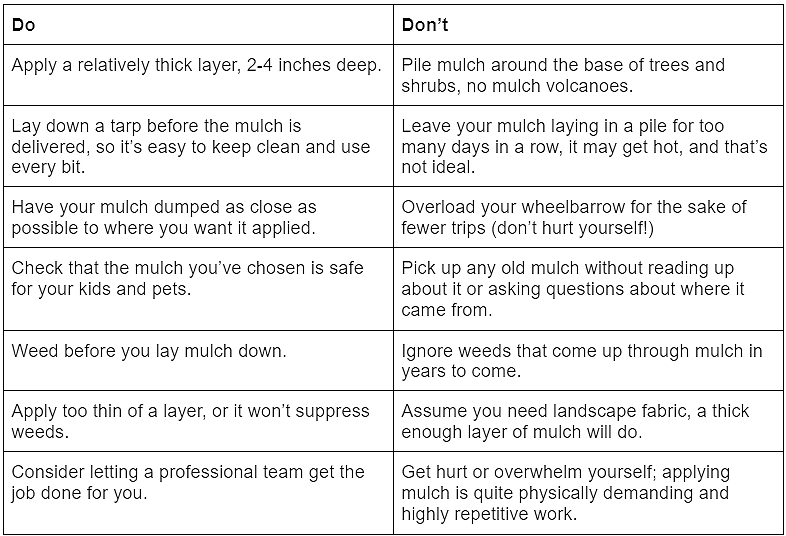
Effects of Location and Climate on Mulching
Effectiveness in Different Climates
The effectiveness of mulching can vary depending on the climate and environmental conditions. In regions with hot and dry climates, mulching plays a crucial role in moisture retention and helps protect plants from excessive heat and evaporation. In contrast, in cooler or more humid climates, mulch can help regulate soil temperature and reduce moisture loss, promoting optimal growing conditions.
Adaptation to Local Soil Conditions
The type of soil present in a particular location can influence the effectiveness of mulching. For example, mulching in sandy soils, which have low water-holding capacity, can significantly improve moisture retention. In clay soils, mulching helps prevent soil compaction and enhance drainage. Understanding the specific soil characteristics of a given area is essential for choosing the appropriate mulch and maximizing its benefits.
Compatibility with Local Plant Species
Different plant species have varying requirements and tolerances when it comes to mulching. Some plants may benefit from mulch that retains more moisture, while others prefer a drier or more well-drained environment. Considering the specific needs of the plants in a given location is important to ensure compatibility with the chosen mulching strategy and to avoid any negative impacts on plant health.
Influence on Heat Retention
Mulching can have an impact on heat retention in different climates. In hot climates, organic mulches can help keep the soil cooler by blocking sunlight and insulating the soil surface. This prevents excessive heating of the soil and helps protect plant roots from heat stress. In cooler climates, mulching can act as an insulator, retaining soil warmth and protecting plants from cold temperatures and frost damage.
Monitoring and Adjusting Mulch
Importance of Regular Monitoring
Regular monitoring of mulch is essential to ensure its effectiveness and address any potential issues. This includes inspecting the mulch layer for signs of compaction, checking for adequate thickness, and assessing overall mulch condition. Monitoring also involves observing plant health and addressing any changes or symptoms that may indicate problems related to mulching.
Adjusting Mulch Thickness and Composition
Mulch thickness and composition may need to be adjusted periodically to maintain optimal conditions for plant growth. As organic mulches decompose over time, they may thin out or break down unevenly, reducing their effectiveness. It is important to replenish mulch as needed and ensure a consistent layer thickness. Adjusting the mulch composition may also be necessary if there are changes in soil conditions, plant requirements, or desired outcomes.
Identifying Signs of Pests or Disease
Regular monitoring of mulch allows for early identification of potential pest infestations or disease outbreaks. Inspecting the mulch layer and plant foliage for signs of pests, such as chewed leaves or visible insects, can help prevent the spread of infestations. Additionally, monitoring for any signs of plant diseases, such as wilting or discoloration, allows for timely intervention and treatment.
Preventing Excessive Moisture or Dryness
Monitoring mulch moisture levels is crucial to prevent either excessive moisture or dryness, both of which can have negative impacts on plant health. Excessive moisture caused by overwatering or poor mulch drainage can lead to root rot or fungal diseases. On the other hand, inadequate moisture levels due to insufficient mulch thickness or improper watering practices can result in drought stress or water loss. Regular monitoring helps maintain proper soil moisture balance.
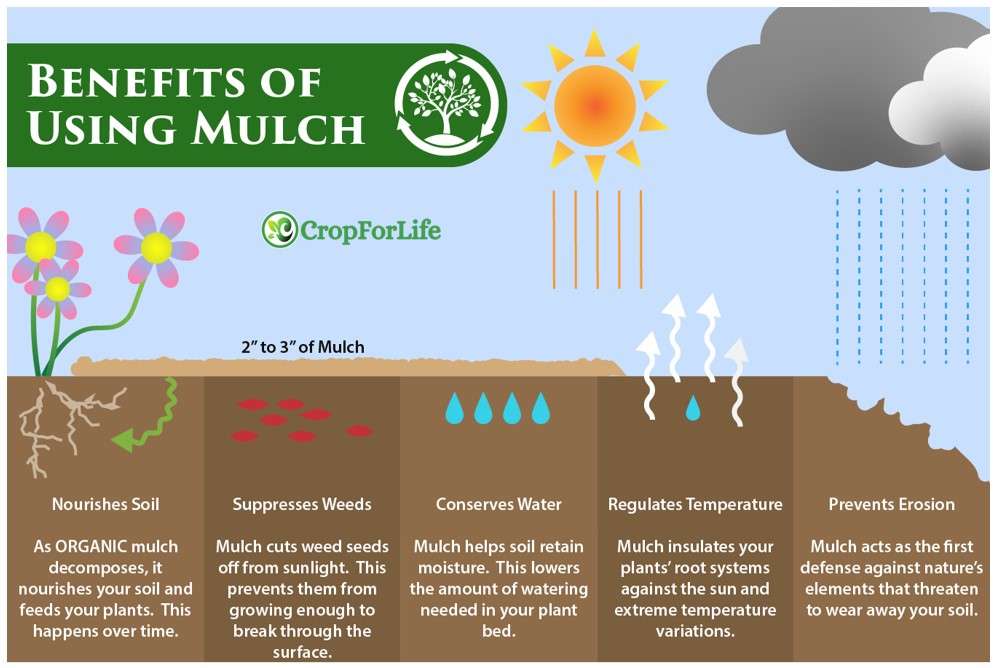
Disadvantages of Organic Mulches
Potential for Attracting Pests
Organic mulches, such as wood chips or straw, have the potential to attract pests due to their organic content. Insects, rodents, or other pests may find shelter in the mulch layer and can cause damage to plants or transmit diseases. Regular inspection and pest control measures are necessary to manage the risk of pest infestations.
Risk of Root Rot if Overused
Overusing organic mulches or piling them too high against the stems or trunks of plants can create an environment conducive to root rot. Excessive moisture and restricted air circulation can lead to fungal diseases that affect the plant’s root system. Proper placement and management of organic mulches are essential to prevent root rot and maintain plant health.
Decomposition Process Affecting Soil
The decomposition process of organic mulches can impact soil characteristics over time. As the mulch breaks down, it releases nutrients into the soil, contributing to soil fertility. However, excessive decomposition can also alter soil pH levels or nutrient availability, potentially affecting plant health. Regular monitoring and adjustments in mulch thickness or composition can help maintain a balanced soil ecosystem.
Difficulty in Controlling Weed Growth
While organic mulches can help suppress weed growth, they are not entirely weed-proof. Weed seeds may still find their way into the mulch layer and germinate, requiring periodic weeding or maintenance. Some organic mulches, such as straw or hay, may even contain weed seeds themselves, further complicating weed control efforts. Vigilance and proactive weed management practices are necessary when using organic mulches.
Nutrient Competition with Plants
Organic mulches compete with plants for nutrients as they decompose. The decomposition process involves the consumption of nitrogen from the soil, which can temporarily reduce nutrient availability for plants. This can result in nutrient deficiencies if not adequately managed. Supplemental fertilization or the use of well-composted organic mulches can help mitigate this issue and ensure optimal nutrient levels for plant growth.
Disadvantages of Inorganic Mulches
Potential for Drying out the Soil
Inorganic mulches, such as gravel or stones, do not retain moisture well and can lead to drying out the soil. These mulch types do not provide the same moisture-holding capacity as organic mulches and may contribute to increased irrigation needs. In areas with limited water availability or in regions prone to drought conditions, inorganic mulches may not be the most suitable choice.
Damage to Plant Roots
Inorganic mulches, particularly those made of rough or sharp materials, can potentially cause damage to plant roots. This can occur if the mulch is spread too close to the base of plants or if it shifts or settles over time, coming into direct contact with delicate roots. Careful installation and periodic maintenance of inorganic mulches are necessary to prevent root damage.
Negative Impact on Soil Ecology
Inorganic mulches do not contribute to the improvement of soil structure or the enrichment of organic matter in the same way that organic mulches do. This can have a negative impact on the overall soil ecology, affecting the diversity and activity of beneficial soil organisms. Regular soil testing and the incorporation of organic amendments are recommended in conjunction with the use of inorganic mulches to maintain a healthy soil ecosystem.
Potential Harm to Wildlife
Some types of inorganic mulches, such as rubber mulch or certain types of plastic mulch, can pose a threat to wildlife if ingested or if animals become entangled in them. It is important to choose mulch materials that are environmentally friendly and non-toxic to minimize any potential harm or disruption to wildlife populations.
Reduced Biodegradability
Unlike organic mulches, inorganic mulches do not biodegrade over time. This means that inorganic mulches may accumulate and require periodic removal or replacement. The lack of biodegradability can increase the long-term maintenance requirements and environmental impact associated with inorganic mulches.
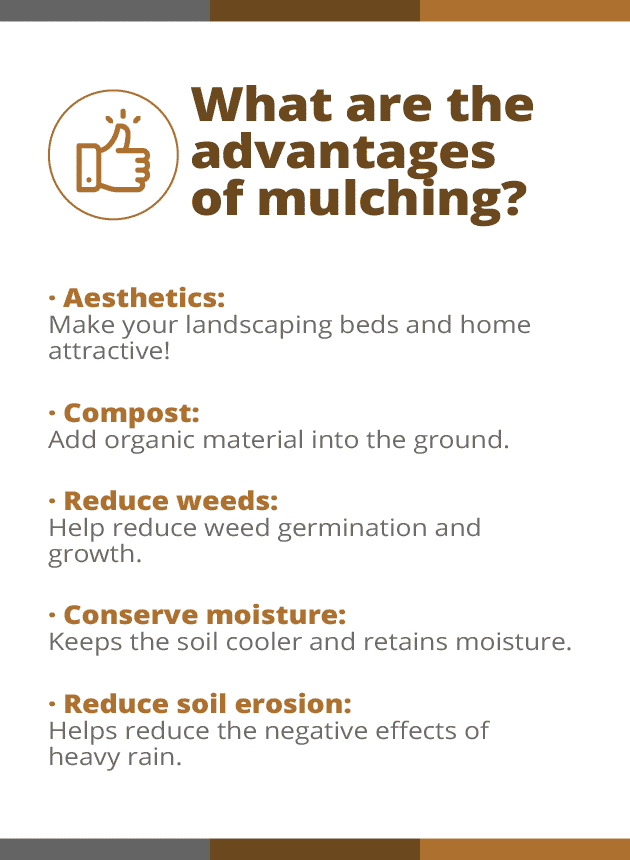
Benefits of Proper Mulching Practices
Mitigating Disadvantages
Proper mulching practices can help mitigate the disadvantages commonly associated with mulching. By monitoring and adjusting the mulch thickness, composition, and placement, gardeners can prevent potential issues such as pest infestations, root rot, or nutrient imbalances. Regular maintenance and adherence to best practices reduce the risks and maximize the benefits of mulching.
Enhancing Plant Health
One of the primary benefits of proper mulching practices is enhanced plant health. By providing optimal conditions for growth, such as moisture retention, weed suppression, and temperature regulation, mulching supports the overall health and vitality of plants. This leads to improved disease resistance, increased productivity, and better aesthetics in the garden or landscape.
Promoting Root Development
Mulching promotes healthy root development by creating a favorable environment for root growth. The consistent moisture levels and insulation provided by mulch encourage root systems to expand deeper into the soil, resulting in stronger and more resilient plants. Well-developed root systems improve nutrient uptake, enhance drought tolerance, and contribute to overall plant stability.
Improving Soil Structure
Proper mulching practices contribute to improving soil structure and fertility. Organic mulches break down over time, enriching the soil with organic matter and essential nutrients. This enhances soil aggregation, aeration, and drainage, facilitating root penetration and the movement of water and nutrients. Improved soil structure supports beneficial soil organisms and encourages long-term soil health.
Conserving Water
Mulching plays a crucial role in water conservation by reducing evaporation and water loss from the soil surface. This is especially important in areas with limited water resources or during periods of drought. By acting as a barrier, mulch prevents water from directly contacting the air, maintaining soil moisture levels and reducing the need for frequent watering.
Reducing Weed Competition
Effective weed suppression is a major benefit of proper mulching practices. By blocking sunlight and creating a physical barrier, mulch inhibits weed seed germination and growth. This reduces weed competition for resources such as water, nutrients, and sunlight, allowing cultivated plants to thrive without the need for excessive manual weeding.
Minimizing Temperature Fluctuations
Mulching helps stabilize soil temperatures and minimizes temperature fluctuations that can stress plants. By insulating the soil and reducing heat absorption, mulch creates a more favorable microclimate for plant roots. This is particularly beneficial in regions with extreme temperature variations or in areas with sensitive or fragile plants.
Increasing Nutrient Availability
Organic mulches gradually release nutrients as they decompose, increasing nutrient availability for plants. This reduces the reliance on synthetic fertilizers and supports sustainable gardening practices. By ensuring a steady supply of essential elements, mulching enhances nutrient uptake and promotes healthy plant growth.
Enhancing Crop Yields
Proper mulching practices have been shown to increase crop yields in various agricultural settings. By providing a favorable growing environment, mulching improves soil fertility, reduces weed competition, and minimizes moisture stress. These factors, combined with enhanced nutrient availability and disease suppression, contribute to increased crop productivity and profitability.
Providing a Protective Barrier
Mulching acts as a protective barrier, shielding plant roots from physical damage and extreme weather conditions. The mulch layer absorbs the impact of heavy rain or strong winds, minimizing soil erosion and protecting the integrity of plant roots. This is particularly important in areas prone to erosion or in landscapes with fragile or newly established plants.
Integrating Mulching with Other Gardening Practices
Companion Planting
Companion planting is the practice of growing complementary plants in close proximity to enhance each other’s growth and health. Mulching can be integrated with companion planting to provide additional benefits such as moisture retention, weed suppression, and temperature regulation. Mulch can also act as a natural barrier, preventing the spread of invasive plants or pests between companion plants.
Crop Rotation
Crop rotation involves the systematic planting of different crops in a specific sequence to optimize soil fertility and minimize pest and disease problems. Mulching can be incorporated into crop rotation practices by adjusting the type of mulch used based on the specific crop requirements or desired outcomes. This helps maintain a healthy soil ecosystem and supports the success of each crop in the rotation.
Watering Techniques
Mulching complements various watering techniques by reducing water loss and increasing irrigation efficiency. When using techniques such as drip irrigation or soaker hoses, mulch helps distribute water evenly, reducing evaporation and increasing moisture penetration. By promoting more targeted watering and preventing runoff, mulching allows for better water conservation and more effective plant hydration.
Fertilizer Application
Mulching can enhance the effectiveness of fertilizer application by reducing nutrient leaching and improving nutrient availability. Organic mulches gradually release nutrients as they decompose, providing a continuous supply of essential elements that can be absorbed by plant roots. This reduces the reliance on synthetic fertilizers and contributes to sustainable nutrient management practices.
Pruning and Trimming
Mulching supports pruning and trimming practices by providing a protective layer around plants. After pruning, mulch helps shield the exposed areas from excessive temperature fluctuations or potential disease entry. It also acts as a visual marker, defining the area around plants and making it easier to navigate while pruning or trimming.
Soil Testing
Soil testing is a valuable practice to assess soil fertility and nutrient levels. Mulching can be integrated into soil testing procedures by ensuring that the test samples are collected from beneath the mulch layer. This provides an accurate representation of the true soil conditions and helps determine if any adjustments or amendments are needed. Mulch can then be reapplied accordingly, taking into account the test results.
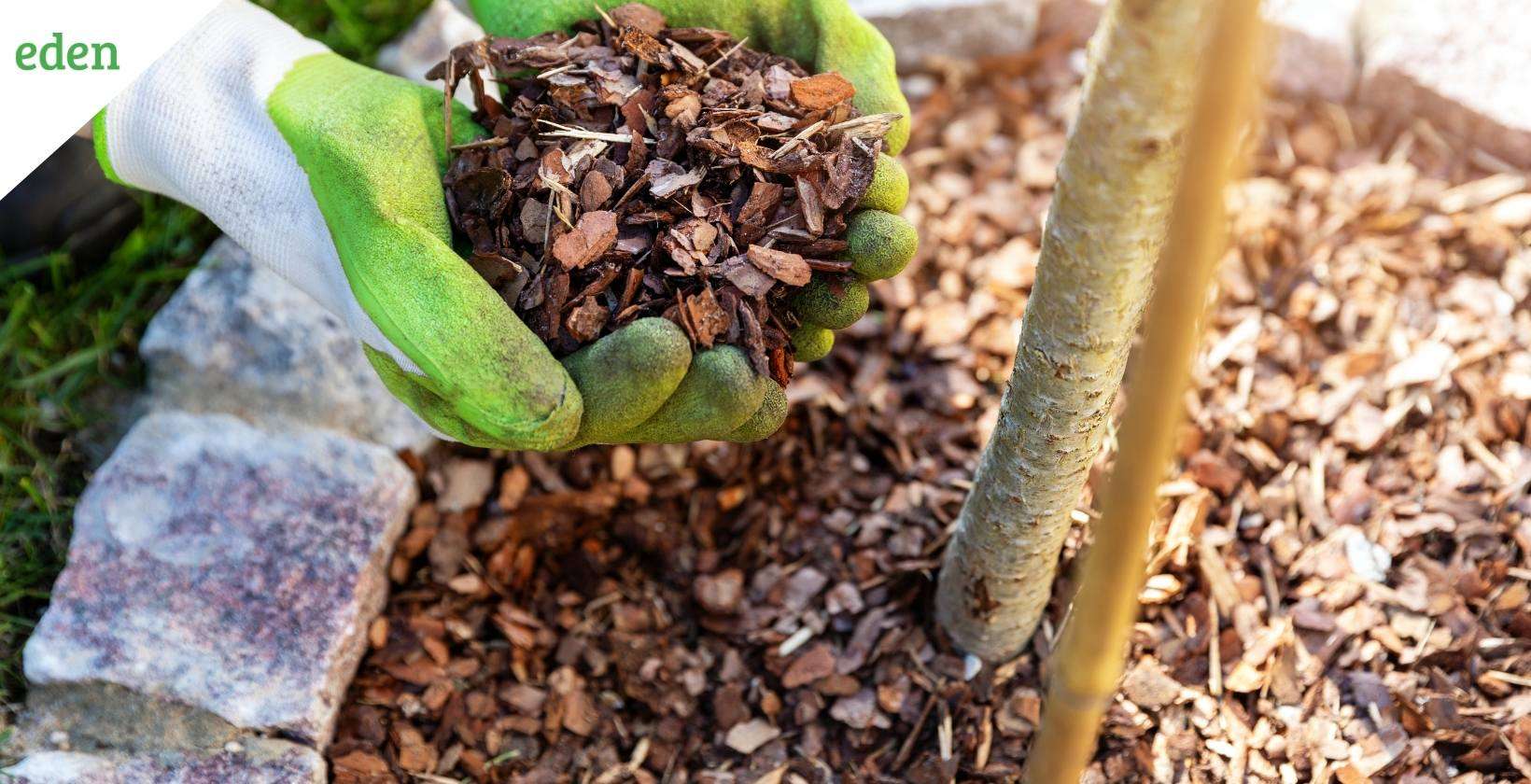
Case Studies on Mulching Effectiveness
Mulching in Commercial Agriculture
In commercial agriculture, mulching is widely adopted to improve crop health, productivity, and profitability. Case studies have shown the positive effects of mulching on various crops, including fruits, vegetables, and row crops. Mulching has been found to enhance soil moisture retention, reduce weed competition, and increase nutrient availability. These factors contribute to higher crop yields, improved quality, and reduced reliance on synthetic inputs.
Mulching in Residential Gardens
Mulching is commonly used in residential gardens to enhance plant health and aesthetics. Case studies have demonstrated that proper mulching practices contribute to increased plant survival rates, reduced weed growth, and improved overall garden appearance. Mulching has also been shown to reduce the need for frequent watering and manual weeding, resulting in time and cost savings for homeowners.
Mulching in Urban Landscapes
In urban landscapes, mulching plays a crucial role in greening initiatives and urban forest management. Case studies have highlighted the positive impact of mulching on tree survival rates, especially in challenging urban environments with poor soil quality and limited water availability. Mulching helps mitigate stressors such as heat island effect, soil compaction, and weed competition, creating better growing conditions for trees and enhancing the overall urban ecosystem.
Mulching in Arid Regions
Mulching is particularly beneficial in arid regions with water scarcity and extreme temperature conditions. Case studies conducted in arid areas have demonstrated the effectiveness of mulching in conserving soil moisture, reducing water loss through evaporation, and improving crop productivity. Mulching helps address the challenges associated with limited water resources, enabling sustainable agriculture in arid and semi-arid climates.
Research and New Developments in Mulching
Innovative Mulching Materials
Ongoing research and development efforts have led to the emergence of innovative mulching materials with unique properties and benefits. Examples include biodegradable mulches made from plant-based materials or compostable polymers. These materials offer similar benefits to traditional mulches while minimizing environmental impact and reducing long-term maintenance requirements.
Effectiveness of Different Mulch Types
Research continues to evaluate the effectiveness of different mulch types in various growing conditions and crop systems. Studies compare the impacts of organic mulches, such as wood chips or straw, with inorganic mulches, such as plastic or stone, on plant growth, soil health, and weed suppression. These research findings inform mulching recommendations and assist gardeners and farmers in making informed choices.
Exploring Alternative Mulching Methods
In addition to different mulch materials, researchers are exploring alternative mulching methods that may offer unique benefits. This includes practices such as living mulch, where desirable plants are intentionally grown as ground covers to suppress weeds and provide additional ecosystem services. These alternative methods provide alternative options for different gardening and farming contexts.
Advancements in Mulch Application Techniques
Advancements in mulch application techniques aim to improve efficiency and coverage while reducing labor and material costs. Innovations include mechanized mulch spreading equipment or precision application methods that achieve uniform mulch thickness. These techniques allow for larger-scale mulching operations or more precise mulch placement, resulting in better mulch performance and cost savings.
Studies on Long-Term Effects of Mulching
Long-term studies are being conducted to assess the sustainability and long-lasting effects of mulching on soil quality and plant health. These studies explore the impact of continuous mulching over several growing seasons, evaluating changes in soil structure, nutrient dynamics, and crop productivity. The results of these long-term studies help refine mulching recommendations and guide best practices for sustainable soil management.
